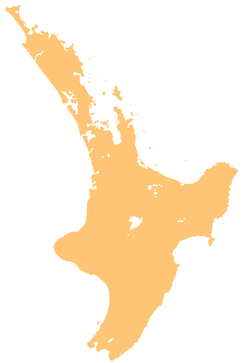Raglan Harbour
|
Raglan Whaingaroa |
|
|---|---|
| Minor urban area | |

Mt. Karioi, Raglan and Whaingaroa Harbour
|
|
| Raglan's location within the North Island | |
| Coordinates: 37°48′S 174°53′E / 37.800°S 174.883°ECoordinates: 37°48′S 174°53′E / 37.800°S 174.883°E | |
| Country | New Zealand |
| Region | Waikato |
| Territorial authority | Waikato District |
| Population (June 2016) | |
| • Total | 3,120 |
| Postcode(s) | 3225 |
Raglan is a small beachside town located 48 km west of Hamilton, New Zealand on State Highway 23. The population of the Raglan statistical unit was 2,637 at the 2006 New Zealand Census in 1,068 households, with a median age of 37 (NZ median 35.9) and median personal income of $18,900 (NZ median $24,400). In 2013 the population of the Raglan statistical area had risen by 99 people to 2,736. The population of the Raglan ward was 4680 in 2006. It had increased to 4920 in 2013.
The area has been inhabited for at least 800 years and was originally known by the Māori people as Whaingaroa (“the long pursuit”). The name Raglan was adopted in 1858 in honour of Fitzroy Somerset, 1st Lord Raglan, who had been the commander of British forces in the Crimean War shortly before.
The first Europeans to settle in the area were the Rev James and Mary Wallis, Wesleyan Missionaries who were embraced and welcomed by local Māori in 1835. European settlement, including large scale conversion of land to pasture, began in the mid-1850s after a large sale of land by Chief Wiremu Neera Te Awaitaia.
The Raglan economy was supported initially by flax and timber exports, followed by farming which is still the mainstay of the area. Tourism and the arts are also significant contributors to the current economy. Raglan and District Museum contains historic artefacts and archives from the region. A new museum building was built in 2011.
The town was the scene for very public civil disobedience campaigns in the 1970s. During World War II the New Zealand Government took local ancestral land from indigenous Māori owners to construct a military airfield. When no longer required for defence purposes, part of the land, a 62-acre (250,000 m2) block, was not returned to the owners but became the public Raglan golf course.
There was widespread protest and attempts to reoccupy the land, and in 1978 20 Māori protesters were arrested on the ninth hole of the golf course. The land was eventually returned to the owners to become a focus for local job-training and employment programs, as well as for the Māori sovereignty movement.
...
Wikipedia

